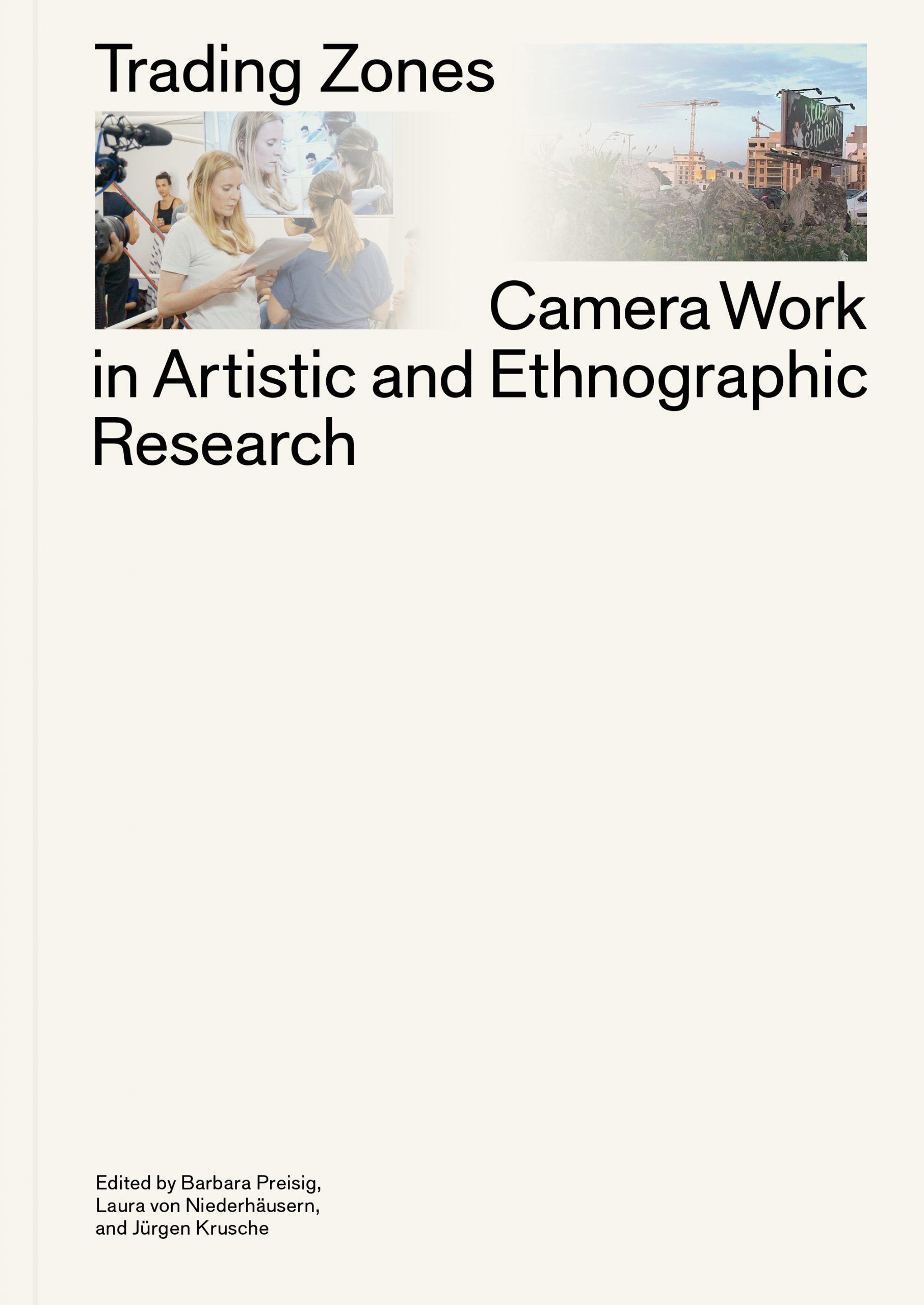Trading Zones: Camera Work in Artistic and Ethnographic Research (2022)
Filed under book | Tags: · anthropology, artistic research, ethnography, film, video

“This book introduces camera-based practices at the intersections of artistic and ethnographic research that critically examine the means of their own production and social embeddedness. In shared practices such as recording in the field, editing in post-production and modes of presentation, the camera is involved as an agent rather than an innocent device. How does the camera grapple with the invisible and how does it reveal what the camerawoman is unable to see? How do films, videos and photographs provide access to vulnerable knowledges and what presentation formats can extend the linearity of narration?
Taking account of their own situatedness and the limits of representation, many of this book’s contributors attempt to speak with — rather than about — the other. These negotiations appearing in the featured projects open up a shared field of artistic and ethnographic inquiry, whose potential — for experiments and reflections — is far from exhausted.”
Contributions by Sepideh Abtahi, Shirin Barghnavard, Laura Coppens, Louis Henderson, Heidrun Holzfeind, Mina Keshavarz, Daniel Kötter, Jürgen Krusche, Bärbel Küster, Bina Elisabeth Mohn, Laura von Niederhäusern, Uriel Orlow, Barbara Preisig, Rani al Raji, Nahid Rezaei, Anette Rose, Sahar Salahshoori, Christoph Schenker, Amira Solh, Lena Maria Thüring, Zheng Mahler.
Edited by Barbara Preisig, Laura von Niederhäusern, and Jürgen Krusche
Publisher Archive Books, Berlin
Creative Commons BY-NC-ND 4.0 license
ISBN 9783948212827
164 pages
PDF (from publisher, 148 MB)
PDF (reduced size, 5 MB)
Steina: Machine Vision (1978–)
Filed under video | Tags: · art, environment, installation, installation art, kinetic art, media art, op art, video, video art, vision
An electro-opto-mechanical environment by Steina, with instrumentation by Josef Krames, Woody Vasulka, and Bruce Hamilton. First shown at the Vasulkas exhibition at Albright-Knox Art Gallery in Buffalo, NY, 1978.
“When a human being operates the camera, the assumption is that the camera is an extension of the eye. You move the camera the way you move the head and the body. In video, unlike photography or film, the viewfinder is not necessarily an integral part of the camera apparatus. … In the late 1970s, I began a series of environments titled Machine Vision and Allvision, with a mirrored sphere. Another variation has a motorized moving mirror in front of the camera so that depending on the horizontal or vertical positioning of the mirror, the video monitor displays a continuous pan or tilt either back/forth or up/down. A third variation is a continuous rotation through a turning prism, while still another has a zoom lens in continuing motion, in/out. These automatic motions simulate all possible camera movements freeing the human eye from being the central point of the universe.” (Steina)
Recorded at the Palazzo delle Esposizioni, Rome, 1994/1995
Artist statement and documentation (artist’s website archive with restored videos)
WEBM (42 MB)
Comment (0)Chris Robé: Breaking the Spell: A History of Anarchist Filmmakers, Videotape Guerrillas, and Digital Ninjas (2017)
Filed under book | Tags: · activism, aesthetics, aids, anarchism, autonomy, direct action, ecology, film, indigenous peoples, labour, marxism, media activism, neoliberalism, politics, protest, punk, social movements, strike, third cinema, video, video activism, video art

“Breaking the Spell offers the first full-length study that charts the historical trajectory of anarchist-inflected video activism from the late 1960s to the present. Two predominant trends emerge from this social movement-based video activism: 1) anarchist-inflected processes increasingly structure its production, distribution, and exhibition practices; and 2) video does not simply represent collective actions and events, but also serves as a form of activist practice in and of itself from the moment of recording to its later distribution and exhibition. Video plays an increasingly important role among activists in the growing global resistance against neoliberal capitalism. As various radical theorists have pointed out, subjectivity itself becomes a key terrain of struggle as capitalism increasingly structures and mines it through social media sites, cell phone technology, and new “flexible” work and living patterns. As a result, alternative media production becomes a central location where new collective forms of subjectivity can be created to challenge aspects of neoliberalism.
Chris Robé’s book fills in historical gaps by bringing to light unexplored video activist groups like the Cascadia Forest Defenders, eco-video activists from Eugene, Oregon; Mobile Voices, Latino day laborers harnessing cell phone technology to combat racism and police harassment in Los Angeles; and Outta Your Backpack Media, indigenous youth from the Southwest who use video to celebrate their culture and fight against marginalization. This groundbreaking study also deepens our understanding of more well-researched movements like AIDS video activism, Paper Tiger Television, and Indymedia by situating them within a longer history and wider context of radical video activism.”
Publisher PM Press, Oakland, CA, 2017
ISBN 9781629632339, 1629632333
x+469 pages
Interview with author: The New Architects (video, 2017, 43 min).
Reviews: Beth Geglia (Interface, 2017), Franklin Lopez (Fifth Estate, 2017), Patricia R. Zimmerman (Jump Cut, 2018), Allan Atliff (Anarchist Studies, 2017).
PDF (16 MB)
Academia.edu (author)

